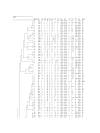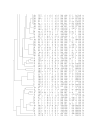Molecular epidemiology of pneumococci obtained from Gambian children aged 2-29 months with invasive pneumococcal disease during a trial of a 9-valent pneumococcal conjugate vaccine
- PMID: 18547404
- PMCID: PMC2440749
- DOI: 10.1186/1471-2334-8-81
Molecular epidemiology of pneumococci obtained from Gambian children aged 2-29 months with invasive pneumococcal disease during a trial of a 9-valent pneumococcal conjugate vaccine
Abstract
Background: The study describes the molecular epidemiology of Streptococcus pneumoniae causing invasive disease in Gambian children
Methods: One hundred and thirty-two S. pneumoniae isolates were recovered from children aged 2-29 months during the course of a pneumococcal conjugate vaccine trial conducted in The Gambia of which 131 were characterized by serotyping, antibiotic susceptibility, BOX-PCR and MLST.
Results: Twenty-nine different serotypes were identified; serotypes 14, 19A, 12F, 5, 23F, and 1 were common and accounted for 58.3% of all serotypes overall. MLST analysis showed 72 sequence types (STs) of which 46 are novel. eBURST analysis using the stringent 6/7 identical loci definition, grouped the isolates into 17 clonal complexes and 32 singletons. The population structure of the 8 serotype 1 isolates obtained from 4 vaccinated and 2 unvaccinated children were the same (ST 618) except that one (ST3336) of the isolates from an unvaccinated child had a novel ST which is a single locus variant of ST 618.
Conclusion: We provide the first background data on the genetic structure of S. pneumoniae causing IPD prior to PC7V use in The Gambia. This data will be important for assessing the impact of PC7V in post-vaccine surveillance from The Gambia.
Figures




References
-
- Shann F. Etiology of severe pneumonia in children in developing countries. Pediatr Infect Dis. 1986;5:247–252. - PubMed
-
- Adegbola R, Falade A, Sam B, Aidoo M, Baldeh I, Hazlett D, Whittle H, Greenwood B, Mulholland E. The etiology of pneumonia in malnourished and well-nourished Gambian children. Pediatr Infect Dis J. 1994;13:975–982. - PubMed
Publication types
MeSH terms
Substances
Grants and funding
LinkOut - more resources
Full Text Sources
Other Literature Sources
Medical

